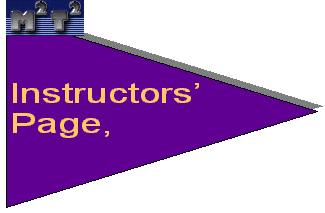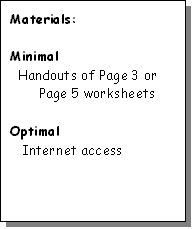|
|
|
||||||||||||
|
Goal of Part 1: A primary goal of number sense is to build an understanding of how numbers are used in many different aspects of life. The activities in Part 1 ask students to recognize that numbers are used for different purposes and require different labels depending on the context. Objectives of Part 1
|
Opening Activity: How high can you go, how far can you see? Context: This activity utilizes familiar places and people to help students make sense of numbers. Several numerical facts are stated, except that the numbers are removed from the statements. Students must estimate reasonable heights, weights, and distances to choose which number belongs in each blank, choosing from the list of numbers on the right. Some analysis of the statements is required in order to be able to choose the correct number (e.g._____feet per minute is equivalent to _____mph). Students must also understand scientific notation (e.g. 16,100 is equivalent to 1.61 x 104). Activity Instructions (version 1) 1. Distribute copies of version 1 of the Sears Tower activity to all students. Have students work independently for 10 – 15 minutes filling in the blanks with the numbers. Remind students that the numbers are grouped for each paragraph. 2. Group students in groups of three to compare and discuss their answers. Ask them to verify their answers by showing their calculations, where appropriate (e.g., Michael Johnson’s speed in feet per minute and miles per hour). 3. When most groups have finished, ask some groups to report their results and procedures for verifying their answers.
|
||||||||||||
|
|
Discussion of Math Content and Related Questions: - Discuss the different ways that we use numbers in everyday life. Can you separate the different numbers in this article into different categories? Which ones? Why did you decide to categorize the numbers in this particular way? - For example, sometimes numbers are used as counts---there are 110 floors, you can see 4 states. Other times, we use numbers as measures---it weighs 225,000 tons and is 1454 feet high. - Often we use two different numbers as benchmarks to make comparisons that help us grasp unusually large or “fantastic” quantities—it would take 224 Michael Jordans standing on top of each other to equal the height of the Sears Tower. This tendency to make comparisons to give reality to extreme quantities leads to the formation of ratios (which will be explored more in Part 3). -Another important aspect of this activity and discussion are the use of labels: What labels are appropriate for a particular use of a number as a count? As a measure? As a ratio? Why do we write some numbers as scientific notation and other shortcuts such as “1.5 million”?
|

